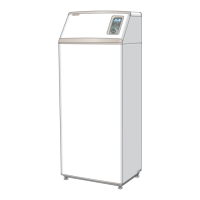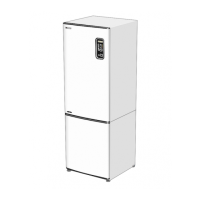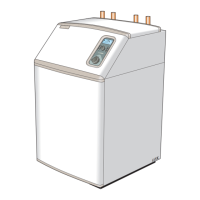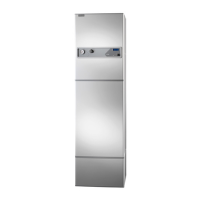General information for the installer
FIGHTER 1320
8
In accordance with applicable regulations, heating
installations must undergo an installation inspection
before being commissioned. The inspection must be
carried out by a suitably qualified person. The above
applies to closed heating systems. If the heat pump is
replaced, the installation must be inspected again.
The FIGHTER 1320 must be installed on a firm sur-
face, preferably a concrete floor or a concrete founda-
tion in a boiler room or a separate equipment room.
Avoid installing it in or adjacent to a sound-sensitive
room. Wherever the unit is located, any wall that
backs on to a bedroom should be fitted with sound
insulation.
The FIGHTER 1320 must be transported and stored
upright and dry.
Transport and storage
Installation
Collectors
Inspection of the installation
The maximum length of each loop is 500 metres.
The hose normally used is PEM hose 40 x 2.4 PN 6.3.
The length of the collector hose varies depending on
the rock/soil conditions and on the heating system,
e.g. radiators or underfloor heating.
Collectors are always connected in parallel, with some
means of adjusting the flow.
For surface soil heat, the hose should be buried at a
depth of about 1 metre and the distance between the
hoses should be at least 1 metre.
For rock heat, there must be a distance of at least 15
meters between boreholes.
Soil heat Rock heat
Type recommended recommended
collector length active drilling depth
25 3 x 375 – 3 x 500 m 3 x 125 – 4 x 150 m
40 4 x 500 – 6 x 500 m 4 x 170 – 5 x 200 m
20 3 x 300 – 3 x 400 m 2 x 150 – 3 x 150 m
30 3 x 450 – 4 x 450 m 3 x 150 – 5 x 150 m
Several FIGHTER 1320s can be interconnected to
work together. This is done by selecting one heat
pump as the Master and the others as Slaves. Exter-
nal units, e.g. oil boiler, are connected to the Master
unit. Each Slave is given a unique address for com-
munication with the Master unit. See the section
Description of functions - Start up > Master/Slave.
Master / Slave
FIGHTER 1320 can be controlled up to a certain point
using signals from an external system (e.g. DUC). See
the section Description of functions - External control.
External control (e.g. DUC)
NOTE!
The sensor and communication cables
must not be routed closed to the power cable.
This applies to all external sensors and
all communication cables.
When cable conduit is used for the outdoor
sensor this should be sealed to prevent
condensation in the outdoor sensor capsule.

